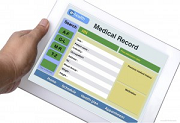ELECTRONIC HEALTH RECORDS (EHRs) AND PATIENT WORK INFORMATION

Rationale for Including Work Information in EHRs
Why include information about work in EHRs?
On average, American workers spend close to half their waking hours at work. As a result, work can have significant impacts on health. In turn, health affects one’s ability to work. Yet information about work is not routinely included in medical records. Having patient work information readily available in EHRs will help healthcare providers access useful information and tools to identify, diagnose and treat work-related conditions and manage non-work-related conditions.
Work information that can be useful to the care provider includes the patient’s current or most recent occupation and the industry they work in. Information about the patient’s longest held, or “usual”, job also is important, especially for recognition of conditions that may appear after the person has stopped working in that job.
Supporting patient care
Information on a patient’s occupation and the industry in which a person works can be used by healthcare providers to protect a patient’s health. A healthcare provider can access information about health hazards associated with a patient’s job and the types of health problems that workers in that job may experience. Management of many “non-occupational” conditions also can be enhanced with information about a patient’s work. For example, work schedule and working conditions can affect a diabetic patient’s ability to control their blood glucose levels or take their medication. Healthcare providers also can use information about work tasks and demands to make decisions about how to safely return their patients to work following an illness or injury.
Identifying groups of patients at risk – population health
Including work information in EHRs also can assist healthcare organizations to improve the health of populations in their care, such as by identifying groups of working patients at risk of certain conditions. EHRs are often used to generate “patient lists” – (e.g., lists of patients with certain health conditions) – in order to identify patients with the greatest need for follow-up or additional care. Generating patient lists by industry or occupation could be very valuable. For example, a healthcare organization could identify all patients working in construction or house painting occupations and use this list to identify workers who might benefit from a blood lead test.
Supporting public health activities
Surveillance is the ongoing monitoring of the health of populations (not only within one healthcare organization), such as groups of workers defined by occupation (e.g., construction workers) or industry (e.g., healthcare workers). Including work information in EHRs will enable public health agencies or other authorized users of aggregated health data to track the health status of worker groups. The knowledge gained by these analyses can in turn be made available to healthcare providers, through EHR clinical decision support tools or by other means, to improve patient health.
For example, cancer is one area where patient work information is useful for surveillance. When medical records contain patient industry and occupation information, public health agencies can determine which worker groups are experiencing higher rates of cancer, and form hypotheses about occupational causes of cancer. In fact, the law that establishes cancer registries (the Cancer Registries Amendment Act) requires the reporting of industry and occupation, when that information is available in the medical record. Therefore, including patient industry and occupation information in EHRs will improve cancer reporting.
Including patient work information in EHRs will also support the reporting of cases of occupational conditions to state health departments. Currently, 30 states require healthcare providers to report select occupational conditions (injuries, illnesses, and clusters of disease) to state health departments. This “case-based” reporting helps identify groups of workers at risk of occupational illness and injury and specific workplaces with hazardous conditions. Case-based reporting also can help public health practitioners to identify “emerging” or new occupational health problems.
Including patient work information in EHRs also can enhance reporting of “non-occupational” conditions, such as infectious diseases. All states report cases of certain illnesses (“nationally notifiable conditions”) to the Centers for Disease Control and Prevention (CDC). Reporting information about a patient’s work with other case information allows public health experts to identify routes of transmission in cases where infectious diseases are spread through workplaces.
- Page last reviewed: April 2, 2015
- Page last updated: June 17, 2016
- Content source:
- National Institute for Occupational Safety and Health Respiratory Health Division


 ShareCompartir
ShareCompartir